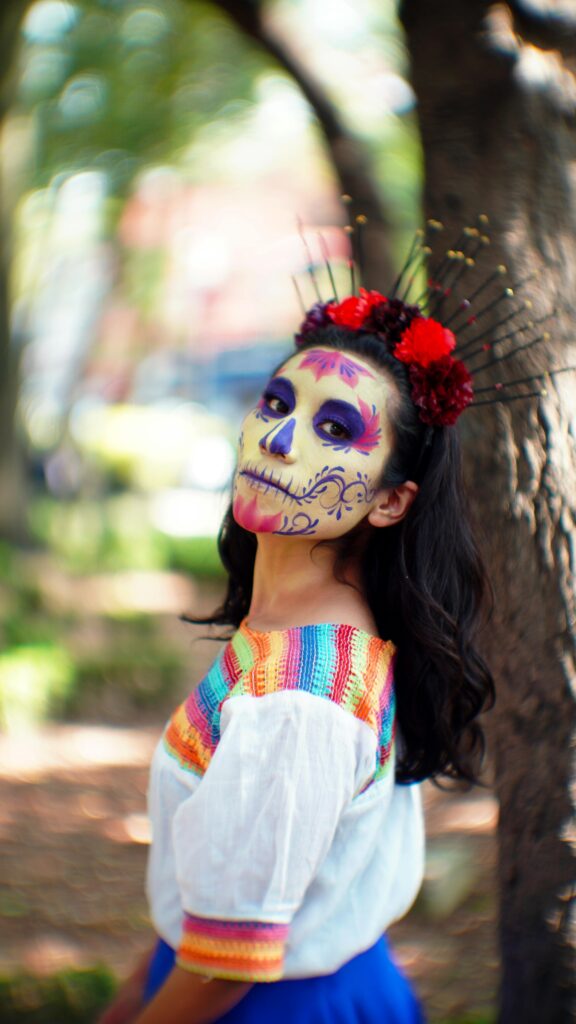When Halloween and Día de Muertos (Day of the Dead) roll around, many people wonder: are these two celebrations the same? While both holidays share a focus on honoring the dead, their customs, origins, and meanings are quite different. In this article, we’ll explore the differences between Día de Muertos and Halloween, dive into Spanish traditions, and how these two celebrations reflect rich cultural practices. Whether you’re in Spain, Singapore, or Latin America, understanding these traditions will give you a deeper appreciation for Spanish vocabulary and customs!

What Is Día de Muertos?
Día de Muertos is a significant holiday celebrated in Mexico and other Latin American countries. It is deeply rooted in Spanish tradition and indigenous practices, focusing on remembering and honoring loved ones who have passed away. The celebration typically spans two days: November 1st (All Saints’ Day) and November 2nd (All Souls’ Day).
During this time, families create altars with Spanish words for everyday items like candles, flowers, and sugar skulls, each symbolizing an offering to the deceased. Spanish vocabulary such as “ofrenda” (offering) and “calavera” (skull) are essential to understanding this beautiful tradition.
Tip: If you’re traveling to a Latin American country around this time, learning these Spanish words for travel will help you engage in conversations about this cultural celebration. You’ll be able to appreciate the traditions more fully, whether in Spain or Singapore!
How Is Día de Muertos Different from Halloween?
While both Día de Muertos and Halloween take place around the same time of year, their purposes and practices differ significantly.
- Origin and Purpose
- Día de Muertos has roots in Latino American tradition, blending indigenous beliefs with Catholicism. The celebration is about honoring the spirits of the deceased, ensuring their journey to the afterlife is peaceful.
- Halloween, on the other hand, has its origins in ancient Celtic festivals, particularly Samhain. It was a time to mark the transition between the harvest and the cold winter months, often associated with spirits and supernatural forces.
- Celebration Style
- Día de Muertos is a joyous celebration. Families gather to create altars with offerings like food, drinks, and personal items that their loved ones enjoyed in life. They believe that the deceased return to enjoy these offerings.
- Halloween is more about dressing up in costumes and trick-or-treating. The mood can range from spooky to fun, but the focus is primarily on entertainment.
- Symbols
- In Día de Muertos, you’ll see colorful marigolds, decorative skulls, and candles. These symbols represent the life and death cycle and are meant to welcome spirits back to the living world.
- Halloween features pumpkins, ghosts, witches, and bats, symbols that stem from ancient beliefs in the supernatural.
Why Should You Learn About Día de Muertos?
If you’re learning Spanish or planning to travel to Latin America, understanding the significance of Día de Muertos is crucial. This celebration is not just a holiday; it’s a profound reflection of culture, love, and respect for the deceased. By learning about it, you’ll deepen your knowledge of Spanish vocabulary and how customs vary across Spanish-speaking countries.
Our Spanish School offers various courses to help you connect with cultural traditions like Día de Muertos. Whether you need business Spanish, are preparing for a Spanish certification exam, or want to practice conversational skills, we’ve got the perfect course for you!
How Can You Participate in Día de Muertos?
If you’re in a Spanish-speaking country or attending a celebration abroad, here are some ways to join in the fun and honor Día de Muertos:
- Create an Ofrenda: Learn the Spanish words associated with creating a traditional altar. You’ll find that even the simplest Spanish everyday words like “vela” (candle) and “pan de muerto” (bread of the dead) can have significant meaning.
- Dress Up: Embrace the fun side of Día de Muertos by painting your face like a calavera (skull) or wearing traditional clothing.
- Enjoy the Food: Experience authentic foods like tamales and pan de muerto. These are staples during the holiday and are often prepared as offerings to the spirits.
Take Your Spanish Skills to the Next Level with Us
Want to dive deeper into Spanish traditions like Día de Muertos? Our Spanish courses can help! Whether you’re looking for business Spanish, need to prepare for an exam, or simply want to improve your conversational skills, our teachers are here to guide you through every step. With us, you’ll learn the Spanish vocabulary and cultural context you need to truly understand traditions like Día de Muertos.
Are you planning a trip to Spain or Latin America? Our courses also focus on teaching Spanish words for travel, ensuring you’re ready for your next adventure. We can’t wait to help you improve your Spanish while exploring the fascinating world of Día de Muertos!
Ready to Learn More About Día de Muertos?
By now, you’ve learned that while Día de Muertos and Halloween may seem similar at first glance, they represent distinct cultural traditions. Embrace the joy and meaning of Día de Muertos and dive into the world of Spanish language and culture!
Join our Spanish School today and start your journey toward mastering Spanish vocabulary, exploring fascinating traditions, and becoming fluent in one of the world’s most widely spoken languages. Whether you’re in Singapore, Spain, or beyond, we’re here to help you unlock the full potential of your Spanish language skills!
Don’t miss out—enroll today, and let us guide you through the beautiful language and traditions of the Spanish-speaking world!
